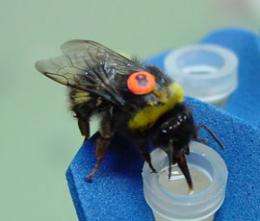Complex mathematical problem solved by bees

(PhysOrg.com) -- Bumblebees can find the solution to a complex mathematical problem which keeps computers busy for days.
Scientists at Queen Mary, University of London and Royal Holloway, University of London have discovered that bees learn to fly the shortest possible route between flowers even if they discover the flowers in a different order. Bees are effectively solving the 'Travelling Salesman Problem', and these are the first animals found to do this.
The Travelling Salesman must find the shortest route that allows him to visit all locations on his route. Computers solve it by comparing the length of all possible routes and choosing the shortest. However, bees solve it without computer assistance using a brain the size of grass seed.
Professor Lars Chittka from Queen Mary's School of Biological and Chemical Sciences said: "In nature, bees have to link hundreds of flowers in a way that minimises travel distance, and then reliably find their way home - not a trivial feat if you have a brain the size of a pinhead! Indeed such travelling salesmen problems keep supercomputers busy for days. Studying how bee brains solve such challenging tasks might allow us to identify the minimal neural circuitry required for complex problem solving."
The team used computer controlled artificial flowers to test whether bees would follow a route defined by the order in which they discovered the flowers or if they would find the shortest route. After exploring the location of the flowers, bees quickly learned to fly the shortest route.
As well as enhancing our understanding of how bees move around the landscape pollinating crops and wild flowers, this research, which is due to be published in The American Naturalist this week, has other applications. Our lifestyle relies on networks such as traffic on the roads, information flow on the web and business supply chains. By understanding how bees can solve their problem with such a tiny brain we can improve our management of these everyday networks without needing lots of computer time.
Co-author and Queen Mary colleague, Dr. Mathieu Lihoreau adds: "There is a common perception that smaller brains constrain animals to be simple reflex machines. But our work with bees shows advanced cognitive capacities with very limited neuron numbers. There is an urgent need to understand the neuronal hardware underpinning animal intelligence, and relatively simple nervous systems such as those of insects make this mystery more tractable."
Provided by Queen Mary, University of London




















